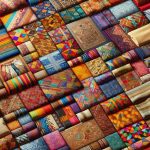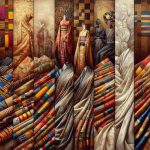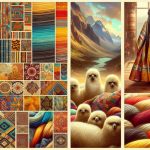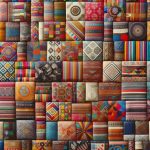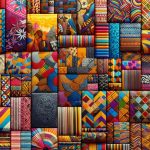Did you know that over 60% of the world's traditional fabrics are still crafted using age-old techniques passed down through generations? When you explore these fabrics, you'll find more than just materials; you'll discover stories of cultural identity and heritage. Whether it's the Kente Cloth of Ghana or the Ikat Weaves of Indonesia, each piece tells a tale that's rich with history and meaning. Curious about how these textiles reflect their origins and the skilled artisans behind them? Let's take a closer look at these fascinating fabrics and their unique significance.
Table of Contents
Key Takeaways
- Kente cloth from Ghana features striking colors and symbolic patterns, worn during significant cultural events.
- Indonesian Ikat weaves use natural dyes and intricate pre-dyeing techniques, reflecting rich cultural heritage.
- Japanese Kimono silk, particularly 'Nishijin' and 'Yūzen', symbolizes status and is integral to festivals and ceremonies.
- Indian sari fabrics showcase diverse regional craftsmanship, with vibrant colors and intricate weaving methods like Banarasi and Kanjeevaram.
- Peruvian alpaca wool is renowned for its softness, thermal properties, and historical significance, celebrated by the Incas.
Kente Cloth of Ghana
Kente cloth, a vibrant textile from Ghana, symbolizes cultural heritage and craftsmanship. You'll find its striking colors and symbolic patterns woven with deep meanings, each telling stories of the Ewe and Ashanti peoples.
Traditionally, Kente cloth is worn as ceremonial attire during significant events like weddings, festivals, and rites of passage. By donning this fabric, Ghanaians showcase their pride, identity, and respect for their ancestors.
The artisan craftsmanship behind Kente cloth is nothing short of extraordinary. Each piece is meticulously handwoven on looms by skilled weavers, who often pass down their techniques through generations.
The intricate designs and patterns in Kente aren't just for aesthetics; they carry historical roots and cultural significance. For instance, certain patterns might represent ethical values, proverbs, or historical events, making each fabric a tapestry of tradition and wisdom.
Ikat Weaves of Indonesia
Known for their elaborate designs and vibrant colors, Ikat weaves from Indonesia showcase a remarkable blend of artistry and tradition. When you explore this alluring textile art, you'll uncover a world rich in cultural heritage and meticulous craftsmanship.
Let's immerse ourselves in what makes Indonesian Ikat so special:
- Natural Dyeing Techniques: The use of natural dyeing methods guarantees that each piece bursts with unique and vibrant colors. Artisans extract dyes from plants, roots, and even insects, resulting in hues that are both daring and eco-friendly.
- Intricate Patterns: The elaborate patterns in Ikat are achieved through a meticulous process where threads are dyed before they're woven. This pre-dyeing practice allows for the creation of intricate and stunning designs that seem almost enchanting.
- Traditional Weaving Methods: Rooted in centuries-old traditions, the weaving process itself is proof of the artisans' skill and dedication. Using hand-operated looms, craftsmen interlace the dyed threads to bring the predetermined patterns to life, preserving the cultural heritage of their communities.
As you admire Ikat weaves from Indonesia, you'll not only see the beauty in each piece but also feel a profound connection to the rich tapestry of human creativity and tradition.
Japanese Kimono Silk
Japanese Kimono silk embodies a timeless elegance that transcends centuries of fashion and culture. When you explore the world of kimono design evolution, you'll notice how each era imparts its unique flair on this iconic garment. The silk weaving techniques employed are nothing short of an art form, requiring meticulous skill and dedication.
| Aspect | Detail |
|---|---|
| Kimono Design | Evolved from simple robes to intricate art |
| Silk Weaving | Techniques like 'Nishijin' and 'Yūzen' |
| Historical Significance | Emperors to commoners, a symbol of status |
| Modern Adaptations | Contemporary fashion, home decor |
| Cultural Impact | Integral to festivals and ceremonies |
Historically, kimonos were more than just clothing; they were symbols of social status and cultural identity. The intricate patterns and luxurious feel of silk signified wealth and sophistication. Modern adaptations of kimono silk extend beyond traditional garments. Today, you'll find its influence in contemporary fashion and even home decor, marrying the old with the new seamlessly.
Understanding the significance of Japanese Kimono silk offers you a deeper appreciation of its role in both historical and modern contexts. Whether you're exploring traditional festivals or contemporary art, kimono silk remains a tribute to Japan's rich cultural heritage.
Indian Sari Fabrics
When you explore Indian sari fabrics, you'll notice their vibrant color techniques that make each piece stand out.
Each region in India has its own unique style, offering a rich diversity of designs.
The intricate embroidery often seen on saris isn't just decorative; it carries deep cultural significance.
Vibrant Color Techniques
India's sari fabrics captivate with their vibrant colors, achieved through traditional dyeing techniques that have been passed down through generations. Mastering these techniques involves a deep understanding of natural dyeing methods and intricate weaving techniques. The artistry lies in the ability to blend historical influences with modern interpretations, creating fabrics that are both timeless and contemporary.
To truly appreciate the vibrancy of Indian sari fabrics, consider these three key aspects:
- Natural Dyeing Techniques: Using plant-based dyes such as indigo, turmeric, and madder root, artisans create rich, enduring hues. These natural dyes not only offer a stunning palette but also guarantee the fabric's longevity.
- Intricate Weaving Methods: Techniques like Banarasi, Kanjeevaram, and Patola weaving require immense skill and patience. The precision in these methods results in exquisite patterns and textures, making each sari a unique masterpiece.
- Historical Influences and Modern Interpretations: The designs and colors reflect a blend of ancient traditions and contemporary trends. Historical motifs are often reimagined with modern color schemes, appealing to both traditional and modern tastes.
Diverse Regional Styles
Among the many regional styles of Indian sari fabrics, each region offers its own unique blend of craftsmanship, tradition, and artistic flair. When you explore the vibrant world of Indian saris, you'll discover how indigenous textiles have evolved into modern adaptations while maintaining their historical essence.
For instance, the Banarasi sari from Varanasi is celebrated for its intricate brocade work, a technique that dates back centuries. These saris are woven from silk and often feature gold and silver threads, making them a staple in contemporary fashion trends.
Another remarkable example is the Kanjeevaram sari from Tamil Nadu. Known for its rich, lustrous silk and intricate patterns inspired by temple architecture, this sari exemplifies the mastery of historical techniques. You'll find that modern adaptations of Kanjeevaram saris incorporate lighter fabrics and contemporary motifs, appealing to today's fashion-forward individuals.
The Bandhani saris from Gujarat and Rajasthan showcase the ancient art of tie-dye, with patterns that remain timeless yet adaptable to current styles. As you explore further, you'll see how these regional styles not only preserve India's rich textile heritage but also seamlessly blend with contemporary fashion trends, offering a perfect marriage of tradition and modernity.
Cultural Significance Embroidery
Embroidery on Indian sari fabrics isn't just decorative; it's a storytelling medium that reflects cultural heritage and regional identity. When you explore these intricate designs, you're delving into a rich tapestry of symbolic meanings and historical contexts. Each stitch and motif holds significance, often passed down through generations.
Consider the following to deepen your understanding:
- Cultural Symbolism: Embroidered elements often embody cultural symbolism. For example, peacocks might represent beauty and grace, while lotus flowers signify purity and enlightenment.
- Regional Identity: Different regions in India have their unique embroidery styles. Zardozi from Uttar Pradesh showcases opulent gold and silver threads, while Phulkari from Punjab uses vibrant, colorful motifs.
- Artisan Techniques: Mastering the craft requires understanding various techniques, such as kantha from West Bengal, which uses simple running stitches to create elaborate patterns.
Understanding these aspects not only enriches your appreciation for Indian sari fabrics but also connects you to the artisans' ancestral legacy. By recognizing the cultural symbolism and intricate designs, you gain a deeper insight into the diverse and vibrant world of Indian embroidery, fostering a greater respect for this timeless art form.
Peruvian Alpaca Wool
You'll be amazed by the unique softness of Peruvian alpaca wool, a fabric that stands out for its luxurious feel.
This wool isn't just about comfort; it also comes from sustainable farming practices that respect both the environment and the animals.
Explore how this traditional fabric combines quality and sustainability.
Unique Softness Qualities
One of the standout features of Peruvian alpaca wool is its unparalleled softness, making it a favorite among luxury fabric enthusiasts worldwide. When you run your fingers through alpaca wool, you'll immediately notice its silky texture, which sets it apart from other natural fibers. This softness isn't just a fleeting sensation; it has deep roots in both the historical significance and modern adaptation of textile innovation.
The unique qualities of alpaca wool stem from its:
- Fiber Structure: Alpaca fibers are smoother and have fewer scales compared to other wools, reducing the itchiness and enhancing softness.
- Temperature Regulation: The fibers possess excellent thermal properties, making garments warm yet breathable.
- Durability: Despite its softness, alpaca wool is incredibly strong, ensuring your garments last longer.
These attributes have cemented alpaca wool's global influence, making it a staple in high-end fashion circles.
Historically, the Incas revered alpaca wool for its luxurious feel and warmth, incorporating it into their most treasured garments. Today, modern designers continue to innovate, blending alpaca wool with other materials to create sophisticated, soft, and versatile textiles.
Sustainable Farming Practices
Beyond its luxurious softness, the production of Peruvian alpaca wool also reflects a commitment to sustainable farming practices that benefit both the environment and local communities. When you choose alpaca wool, you're supporting eco-friendly production methods that guarantee minimal environmental impact.
Alpacas naturally graze gently on the land, preserving soil integrity and promoting biodiversity. Their efficient grazing habits mean they require less water and produce fewer greenhouse gases compared to other livestock.
Ethical sourcing is at the heart of the Peruvian alpaca wool industry. Farmers raise alpacas humanely, ensuring they live in their natural habitats in the Andes. This approach not only respects the animals but also maintains the delicate ecological balance. You'll appreciate knowing that the wool is harvested through ethical practices, where no harm comes to the animals.
Moreover, the community impact is significant. Fair trade practices ensure that local farmers receive fair compensation for their work, improving their quality of life. Your support helps sustain these rural communities, fostering economic stability and growth.
Moroccan Berber Rugs
Moroccan Berber rugs captivate with their complex designs and rich cultural heritage. Each rug tells a unique story, woven by skilled artisans using age-old methods. You'll find these rugs adorned with intricate patterns and colored with organic dyes, which not only enhance their beauty but also reflect the environment and lifestyle of the Berber tribes.
To truly appreciate Moroccan Berber rugs, consider these three aspects:
- Elaborate Patterns: These designs aren't just decorative; they symbolize various aspects of Berber life, from nature to spirituality.
- Organic Dyes: The vibrant colors come from plants, minerals, and even insects, making each rug a piece of sustainable art.
- Weaving Techniques: Passed down through generations, these methods ensure durability and authenticity, giving each rug its distinct tribal design.
Chinese Silk Brocade
Immersed in history and luxury, Chinese silk brocade offers a glimpse into the opulent craftsmanship of ancient China. When you explore this exquisite fabric, you're delving into a domain where silk production has been perfected over millennia, deeply intertwined with Chinese culture.
The art of brocade weaving, known as 'jin,' requires meticulous attention to detail and a profound understanding of the material.
Chinese silk brocade is renowned for its intricate patterns and vibrant colors, each design rich with symbolism. Dragons often signify power and strength, while phoenixes represent rebirth and immortality. Peonies symbolize prosperity, and cranes denote longevity. Every pattern woven into the fabric tells a story, making each piece unique and meaningful.
You're not just looking at a fabric; you're witnessing a historical tapestry that reveals the values and aesthetics of a sophisticated civilization. The luxurious texture and elaborate designs are achieved through labor-intensive techniques, including the use of gold and silver threads.
This level of craftsmanship demands mastery, ensuring that Chinese silk brocade remains a coveted material for those who appreciate unparalleled beauty and cultural significance.
Embrace the legacy of Chinese silk brocade, and you'll understand the true essence of timeless elegance.
Scottish Tartan Plaids
Scottish tartan plaids, with their distinctive patterns and rich history, evoke a deep sense of heritage and identity. Each tartan design, characterized by its unique combination of colors and stripes, tells a story of Scottish clans and regions. You'll find that these historical patterns carry significant cultural symbolism, connecting wearers to their ancestral roots.
To truly appreciate tartan plaids, you should consider:
- Clans and Families: Each clan has its own tartan, serving as a visual representation of lineage and loyalty.
- Regional Variations: Different regions in Scotland have their distinct tartans, reflecting local traditions and history.
- Events and Ceremonies: Tartan is often worn during weddings, funerals, and other cultural events, symbolizing unity and heritage.
In recent years, modern interpretations of tartan have emerged, influencing fashion trends worldwide. Designers now incorporate tartan into contemporary clothing, blending traditional elements with innovative styles. You can see tartan on runways and in high-street fashion, demonstrating its timeless appeal.
Nigerian Aso Oke
Nigerian Aso Oke, a vibrant handwoven fabric, embodies the rich cultural heritage and artistry of the Yoruba people. When you explore the world of Aso Oke, you're immediately struck by its intricate designs and the skillful weaving techniques that have been passed down through generations. Each piece tells a story, capturing the essence of Yoruba history and tradition.
You'll find that Aso Oke isn't just any fabric; it's crafted with precision and care. The weaving techniques involve a meticulous process, where artisans use traditional looms to create patterns that are both intricate and beautiful. These designs often hold symbolic meanings, reflecting the cultural heritage of the Yoruba community.
Aso Oke is mainly used during ceremonial occasions, adding a layer of significance to events like weddings, festivals, and chieftaincy ceremonies. When you wear Aso Oke, you're not just donning a piece of clothing; you're participating in a living tradition. This fabric is a statement to the Yoruba people's dedication to preserving their cultural identity through art.
Frequently Asked Questions
How Are Traditional Fabric Dyes Made Using Natural Ingredients?
You'll discover that natural dyeing techniques involve plants, minerals, and insects. These methods have historical significance, preserving traditional fabric while showcasing artistic expression. Mastering this skill guarantees the longevity and beauty of cultural textiles.
What Are the Environmental Impacts of Traditional Fabric Production?
You'd think traditional fabric production would be eco-friendly, right? Ironically, it often involves water pollution and high energy consumption. Plus, deforestation and an increased carbon footprint can't be ignored. Balancing tradition and sustainability is essential.
How Do Traditional Fabrics Influence Modern Fashion Trends?
You'll see how traditional fabrics shape modern fashion trends through their global influence. They drive fashion evolution by offering rich cultural heritage and unique design inspiration, ensuring that modern designs maintain a connection to historical craftsmanship.
What Tools Are Essential for Weaving Traditional Fabrics?
To master weaving, you'll need a sturdy loom and diligent loom maintenance. Don't forget yarn preparation tools like a warping board and swift. These essentials guarantee your traditional fabric projects are flawless and durable.
How Do Cultural Rituals Affect the Production of Traditional Fabrics?
You'll find that cultural rituals deeply impact the production techniques and sustainable practices of traditional fabrics. Historical influences and cultural significance shape every step, ensuring each piece reflects its rich heritage and unique craftsmanship.
- Tetron Fabric for Marine Applications: Durability and Use Cases - June 18, 2025
- Tetron Fabric for Outdoor Furniture: Weather Resistance and Care - June 18, 2025
- Tetron Fabric for Wall Coverings: Style and Application Tips - June 18, 2025



